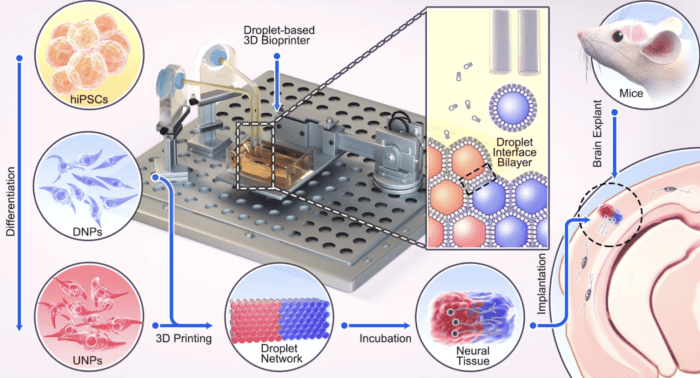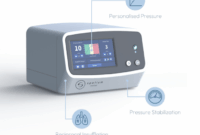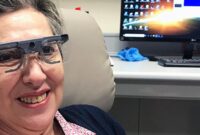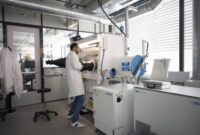3D printed stem cells help treat brain injuries, offering a glimmer of hope for millions struggling with the devastating effects of these conditions. Brain injuries, ranging from mild concussions to severe trauma, often leave individuals with permanent disabilities, affecting their cognitive abilities, motor skills, and overall quality of life.
While current treatment options are limited, the emergence of 3D printed stem cells has ignited excitement in the medical community, paving the way for a revolutionary approach to brain injury recovery.
The concept of 3D printing stem cells is truly groundbreaking. By using biocompatible materials and advanced printing techniques, scientists can create three-dimensional structures that mimic the intricate architecture of human tissues. These structures, containing stem cells, are then implanted into the damaged brain, where they can differentiate into various cell types, potentially regenerating lost tissue, reducing inflammation, and promoting neuroprotection.
The potential benefits of this technology are far-reaching, offering hope for a future where brain injuries are no longer a life-altering sentence.
Brain Injuries and the Promise of 3D Printed Stem Cells
Brain injuries, a significant public health concern, can result from various causes, including accidents, falls, and strokes. The impact of these injuries can be devastating, affecting cognitive function, physical abilities, and overall quality of life. Current treatment options for brain injuries often focus on managing symptoms and promoting recovery, but they have limited success in restoring lost function.
This is due to the complex nature of the brain and the limited ability of existing therapies to regenerate damaged tissue.
The Potential of 3D Printed Stem Cells
The emergence of 3D printed stem cells offers a promising new approach to treating brain injuries. Stem cells are undifferentiated cells with the potential to develop into various specialized cell types. 3D printing technology allows for the creation of complex structures that mimic the natural environment of brain tissue, providing a platform for stem cell growth and differentiation.
The Science Behind 3D Printed Stem Cells
D printing stem cells is a revolutionary technology that has the potential to transform the treatment of brain injuries. This technique allows scientists to create complex, three-dimensional structures that mimic the natural environment of brain tissue, providing a more effective platform for stem cell growth and differentiation.
Materials and Techniques, 3d printed stem cells help treat brain injuries
D printing stem cells involves using biocompatible materials and specialized printing techniques to create scaffolds that support cell growth and differentiation. The materials used in 3D printing stem cells are carefully selected to ensure biocompatibility, meaning they do not trigger an immune response or cause harm to the body.
These materials can include natural polymers like collagen and hyaluronic acid, or synthetic materials like biodegradable polymers.The printing process itself involves depositing layers of biomaterial, containing stem cells, in a precise and controlled manner. Different techniques are used, including:
- Extrusion printing: This method involves extruding a biomaterial through a nozzle, layer by layer, to create the desired 3D structure. The stem cells are often embedded within the biomaterial during the printing process.
- Inkjet printing: This technique uses a nozzle to deposit small droplets of biomaterial containing stem cells onto a surface, layer by layer.
The droplets are precisely placed to create the desired 3D structure.
- Laser-assisted direct writing: This technique uses a laser to selectively remove material from a biomaterial, creating the desired 3D structure. The stem cells are often added to the biomaterial after the printing process.
Advantages of 3D Printed Stem Cells
D printed stem cells offer several advantages over traditional methods of cell transplantation, including:
- Improved Cell Survival and Integration: The 3D printed scaffolds provide a more supportive environment for stem cell growth and differentiation, leading to improved cell survival and integration into the host tissue.
- Enhanced Cell Function: The 3D structure of the scaffolds can promote cell-cell interactions and the formation of functional tissues, enhancing the therapeutic potential of stem cells.
- Precise Control Over Cell Placement: 3D printing allows for precise control over the placement of stem cells within the scaffold, enabling targeted delivery to the injured area.
- Reduced Immunogenicity: The biocompatible materials used in 3D printing can reduce the risk of immune rejection, making the treatment more effective.
Types of Stem Cells Used in Brain Injury Treatment
Different types of stem cells are used in brain injury treatment, each with unique properties and therapeutic potential:
- Mesenchymal Stem Cells (MSCs): MSCs are multipotent stem cells found in bone marrow and other tissues. They have the ability to differentiate into various cell types, including neurons, glial cells, and blood vessels. MSCs have shown promise in promoting tissue regeneration and reducing inflammation in brain injury models.
- Neural Stem Cells (NSCs): NSCs are multipotent stem cells found in the brain that can differentiate into neurons, astrocytes, and oligodendrocytes. They have the potential to replace lost neurons and promote remyelination in brain injuries.
- Induced Pluripotent Stem Cells (iPSCs): iPSCs are generated by reprogramming adult cells, such as skin cells, into a pluripotent state, allowing them to differentiate into any cell type in the body.
iPSCs offer a promising source of stem cells for brain injury treatment, as they can be derived from the patient themselves, reducing the risk of immune rejection.
Applications of 3D Printed Stem Cells in Brain Injury Treatment: 3d Printed Stem Cells Help Treat Brain Injuries
The potential of 3D printed stem cells to revolutionize brain injury treatment is immense. This technology holds promise for regenerating damaged brain tissue, reducing inflammation, promoting neuroprotection, and ultimately improving cognitive function and motor skills.
Regenerating Damaged Brain Tissue
D printed stem cells can potentially regenerate damaged brain tissue by replacing lost or damaged neurons and supporting the growth of new neural connections. The process involves using biocompatible materials like hydrogels or bioceramics to create a scaffold that mimics the structure of brain tissue.
Remember to click german startup marvel fusion laser colorado to understand more comprehensive aspects of the german startup marvel fusion laser colorado topic.
Stem cells are then incorporated into the scaffold, where they can proliferate and differentiate into various types of brain cells, including neurons, astrocytes, and oligodendrocytes. These newly formed cells can then integrate into the surrounding brain tissue, contributing to functional recovery.
Reducing Inflammation and Promoting Neuroprotection
Inflammation is a natural response to brain injury, but excessive inflammation can exacerbate damage and hinder recovery. 3D printed stem cells have the potential to reduce inflammation by secreting anti-inflammatory factors, such as cytokines and growth factors. Additionally, these cells can promote neuroprotection by releasing factors that protect neurons from damage and promote their survival.
Improving Cognitive Function and Motor Skills
The ability of 3D printed stem cells to regenerate brain tissue and promote neuroprotection could lead to improvements in cognitive function and motor skills following brain injury. Studies have shown that stem cell therapy can improve memory, attention, and executive function in animal models of brain injury.
Furthermore, stem cells can promote the regeneration of nerve fibers, which are essential for motor control, potentially leading to improved movement and coordination.
Research and Clinical Trials
The field of 3D printed stem cells for brain injury treatment is rapidly evolving, with ongoing research and clinical trials exploring its potential. These efforts aim to understand the safety and efficacy of this technology, paving the way for future therapeutic applications.
Current Research Landscape
Current research focuses on various aspects of 3D printed stem cells for brain injury treatment, including:
- Optimizing cell production:Researchers are working to improve the efficiency and scalability of 3D printed stem cell production. This involves refining bioprinting techniques, optimizing cell culture conditions, and developing methods to ensure the consistent production of high-quality cells.
- Enhancing cell survival and differentiation:Studies are exploring ways to enhance the survival and differentiation of 3D printed stem cells after transplantation. This includes investigating the use of biomaterials, growth factors, and other factors that can promote cell integration and function within the injured brain.
- Developing targeted delivery strategies:Research is underway to develop targeted delivery strategies that can direct 3D printed stem cells to specific areas of brain injury. This may involve using biocompatible carriers or incorporating guidance cues within the printed structures to facilitate cell migration.
- Evaluating the long-term effects:Researchers are conducting long-term studies to assess the safety and efficacy of 3D printed stem cells in treating brain injuries. This involves monitoring cell survival, integration, and functional recovery over time.
Ongoing Clinical Trials
Several clinical trials are underway to evaluate the safety and efficacy of 3D printed stem cells for treating various brain injuries, including stroke, traumatic brain injury, and spinal cord injury.
- Stroke:A clinical trial at the University of California, San Francisco, is investigating the use of 3D printed stem cells to improve functional recovery in patients who have suffered a stroke. Preliminary results suggest that the treatment may be safe and may lead to improvements in motor function and cognitive abilities.
- Traumatic Brain Injury:A clinical trial at the University of Pittsburgh is exploring the use of 3D printed stem cells to promote tissue regeneration and reduce inflammation in patients with traumatic brain injury. Early findings indicate that the treatment may be safe and may contribute to improved neurological function.
Challenges and Ethical Considerations
While the potential of 3D printed stem cells for brain injury treatment is promising, several challenges and ethical considerations need to be addressed.
- Ensuring cell safety:It is crucial to ensure that 3D printed stem cells are safe for transplantation and do not pose risks of tumor formation or other adverse effects.
- Maintaining cell quality:The quality and consistency of 3D printed stem cells must be rigorously controlled to ensure their therapeutic efficacy.
- Ethical considerations:The use of stem cells in research and clinical trials raises ethical concerns, including informed consent, potential risks to patients, and the equitable distribution of treatments.
Future Directions and Potential Impact
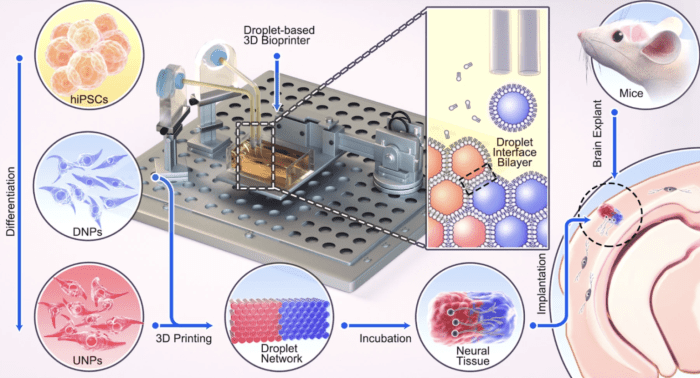
The development of 3D printed stem cells for treating brain injuries is a groundbreaking advancement in regenerative medicine. This technology holds immense promise not only for repairing damaged brain tissue but also for addressing a wide range of neurological disorders.
Expanding Applications to Other Neurological Disorders
The potential of 3D printed stem cells extends far beyond brain injuries. These engineered cells could be tailored to treat various neurological conditions, including:
- Stroke:3D printed stem cells could be used to replace damaged brain cells and promote the formation of new blood vessels, enhancing recovery after a stroke.
- Parkinson’s Disease:Stem cells could be programmed to produce dopamine, a neurotransmitter lost in Parkinson’s, potentially alleviating symptoms like tremors and rigidity.
- Alzheimer’s Disease:3D printed stem cells could be engineered to secrete growth factors that protect existing brain cells from degeneration, slowing the progression of Alzheimer’s.
- Spinal Cord Injuries:3D printed stem cells could be used to bridge gaps in the spinal cord, promoting regeneration and restoring lost function.
- Multiple Sclerosis:Stem cells could be programmed to suppress the immune system’s attack on myelin, the protective sheath around nerve fibers, potentially mitigating the effects of multiple sclerosis.
Transforming Healthcare and Society
The impact of 3D printed stem cell technology extends beyond individual patients. It has the potential to revolutionize healthcare and society in several ways:
- Personalized Medicine:3D printed stem cells can be customized for each patient, tailoring treatment to their specific needs and genetic makeup. This personalized approach could lead to more effective and targeted therapies.
- Reduced Reliance on Drugs:3D printed stem cells could offer a viable alternative to traditional drug therapies, potentially reducing side effects and improving treatment outcomes.
- Increased Access to Treatment:The scalability of 3D printing could make stem cell therapy more accessible to a wider population, reducing the cost and complexity of treatment.
- Economic Benefits:The development and application of 3D printed stem cell technology could create new jobs and industries, boosting the economy and fostering innovation.
- Improved Quality of Life:By offering effective treatments for neurological disorders, 3D printed stem cells could significantly improve the quality of life for millions of people worldwide.
Future Research and Development
Despite its immense potential, 3D printed stem cell technology is still in its early stages of development. Further research and development are crucial to fully realize its promise:
- Improving Cell Differentiation:Researchers need to develop more efficient methods for guiding stem cells to differentiate into specific cell types, ensuring they are precisely tailored for the desired application.
- Enhancing Cell Survival and Integration:Ensuring the survival and integration of 3D printed stem cells into the host tissue is essential for long-term therapeutic success. Further research is needed to optimize the biocompatibility and functionality of these cells.
- Addressing Ethical Considerations:As with any novel technology, ethical considerations must be carefully addressed. Research is needed to establish guidelines for the responsible use of 3D printed stem cells, ensuring patient safety and well-being.
- Clinical Trials and Validation:Large-scale clinical trials are essential to validate the safety and efficacy of 3D printed stem cell therapies. Rigorous testing will be crucial for establishing the long-term benefits and risks of this technology.

